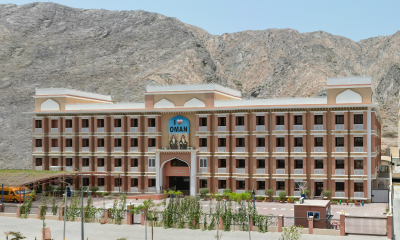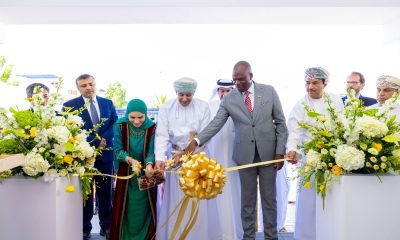Featured
Industry Insights: Oman’s Infrastructure Development 2019

The Sultanate is considered as one of the fastest growing countries when it comes to infrastructure. Due to the flourishing construction industry, it has become a sought-after destination for investment.
RO3.7bn allocated for infrastructure development
Giving a fillip to infrastructure sector, the Sultanate’s government has allocated RO3.7bn for infrastructure development, industrial and services projects in its 2019 budget.
Total investment spending is estimated at RO3.7bn in 2019, including RO1.2bn allocated for infrastructure projects, which are overseen by various government units; and an amount of RO2.5bn to be utilised by some state-owned-enterprises for the implementation of projects in industrial and services sectors.
The 9th five-year development plan (2016-2020) attaches great importance to construction development by ensuring optimum utilisation of resources and investment opportunities in the various governorates in the Sultanate.
The private investments shall be in:
- commodities production activities (32.6%)
- services activities (37%)
- infrastructure (29%)
Contribution to Oman’s GDP
The construction industry accounts for a 9 per cent share of Oman’s GDP and is the country’s largest employer.
The Oman construction market is expected to register a CAGR of 6% over the forecast period, 2019-2024.
The government has said that the spending on development projects will not be cut to ensure the completion of all ongoing projects without delay.

The focus is on the implementation and completion of a number of strategic projects, including:
- Construction of hospitals in Salalah, Khasab, and Suwaiq;
- Water networks projects in a number of wilayats;
- Construction of catering facilities, air cargo terminals and aircraft maintenance hangars at Muscat International Airport and Salalah Airport;
- Implementation of Al Sharqiyah expressway project;
- Implementation of Adam-Thumrait road dualisation project;
- Implementation of infrastructure projects for Liwa City Housing Complex;
- Construction of alternative housing units for the people whose houses were affected by Batinah coastal road project;
- Construction of 400 housing units in Khor Souly (Salalah);
- Construction of a number of new schools, and implementation of additional facilities at some existing schools.
Ongoing Projects in Oman
There are a total of 2,410 active construction projects in Oman, with a combined value in excess of $190 billion.
Ongoing projects comprise:
- 1,840 projects worth $61 billion urban construction projects
- 70 projects worth $39 billion in the oil and gas sector
- 150 projects worth $32 billion in transportation
Furthermore, as many as 230 developments worth more than $29 billion are utility projects, while 110 projects worth $27 billion are industrial sector focused.
Growth Trajectory
Increased government investment in non-oil sectors is expected to boost growth in Oman’s construction sector in 2019 by 11.5 per cent outstripping the MENA construction sector average according to a report by BMI Research, a unit of Fitch Ratings.
BMI predicts continued strong growth for the sector over the course of the next five years.
The upward trajectory is underpinned by Oman’s favourable foreign investment regulations and incentives, as well as an ambitious economic diversification agenda and robust government support for infrastructure sectors like power and water, tourism, and transport and logistics and the establishment of special economic zones to serve as an investment focus for companies seeking infrastructure opportunities.
Strong construction growth in Oman has been driven in large part by focused infrastructure spending, with the government offering a host of opportunities in its development of transportation megaprojects in recent years.
The Sultanate has world-class road networks linking ports, free zones, airports and industrial zones and maintains three deep ports that serve the needs of emerging markets in India, East Africa, Iran and Gulf countries that are fully integrated with its free zones.
Oman’s logistics strategy 2040 is a blueprint designed to transform Oman into a top 10 logistics hub by the year 2040. It includes investments in infrastructure and new technology to upgrade ports, airport facilities, and new road links.

Milestone construction & infrastructure projects
Al Batinah Expressway
The year 2018 witnessed the opening of the largest road project in the history of the Sultanate, the Al Batinah Expressway. With a length of 270km and connecting three governorates, the Expressway starts at the end of the Muscat Highway in Halban and ends at Khatmat Milaha in the Wilayat of Shinas in the Governorate of North Al Batinah. Al Batinah Expressway has been built according to the highest international standards.
Oman-Saudi Road
Oman is also preparing to open a new road that will cut journey times to Saudi Arabia in half by passing through the world’s largest desert. More than 130 million cubic metres of sand were removed as Oman gears up to open the 680km road to Saudi Arabia.
The quickest route between Oman and Saudi Arabia is currently 1,638 kilometres long, passing through the UAE and taking between 16 and 18 hours. The new road is expected to save more than 800km of the journey.
The opening of the road linking Oman with Saudi Arabia, through The Empty Quarter desert, will lead to less traffic at Oman’s border crossings.
Sharqiyah Expressway
Work on the Sharqiyah Expressway project is in full swing, with 80 per cent of the tunnels already completed. Nidab Tunnel has had its civil work and testing completed, with electro-mechanical work currently being executed.
A special construction system was used for the first time in Oman to complete the bridges – this included using specialised cranes for bridge construction work.
Rusayl Industrial City
Public Establishment for Industrial Estates, also known as Madayn, has signed an agreement with Oman Investment and Development Holding Co (Mubadrah) to develop and manage the 11km2 Rusayl Industrial City.
Rusayl will be Oman’s first industrial estate to be managed and operated according to the Sultanate’s regulations for the private sector, and is part of Madayn’s commitment to Oman’s push towards public-private partnerships (PPP).
The timeline between both firms provides Madayn to plan, regulate, monitor, and follow-up on Rusayl Industrial City by 2022, while Mubadrah’s role will cover development, management, and operations as the estate’s main developer. It will also focus on attracting local and international developers as key operators of new estates.
PPP model to spur development
The Sultanate is turning to public-private partnerships to plug gaps in its infrastructure programme. PPPs have an important role to play in meeting Oman’s long-term public infrastructure needs.
The law to encourage PPP projects in various sectors is expected soon. The new PPP Law, which is in an advanced stage of finalisation, has the potential to attract investment in strategic projects and help the country to sustain its economic growth.
The implementation of a comprehensive PPP law can improve the volume and efficiency of PPP transactions while mitigating the costs assigned to the government’s balance sheets.
An effective PPP law also will improve the ability of the Omani government to compete for private sector partners and capital. Although natural resource wealth will mitigate the short-term need for such capital, Oman’s long-term infrastructure needs will require increased utilisation of PPPs as a cost-effective vehicle for programmatic infrastructure development.
Plans are also afoot to attract private investment in infrastructure through investment holding firms, which will facilitate joint venture with active investment from private sector.
For instance, Duqm Development Company (Tatweer), which is the investment arm of Special Economic Zone Authority of Duqm, is planning to attract private investment in Duqm for infrastructure development.
The PPP law will encourage an ideal base to ease the implementation of several joint projects between the government and the private sector. Once the PPP Law comes into effect, an enterprise model for such partnership ventures will emerge, leading to joint investments by government and private entities.
The foundation stone laying ceremony for an affordable housing development built through a public-private partnership (PPP) in the coastal city of Barka was held recently. The mixed-use residential community is a “first-of-its-kind” project for the Sultanate due to its PPP model, which would see “one of the leading real estate companies” develop the community in accordance with international construction standards.
 This article was first published in the 2019-2020 edition of Progress (Al Takkadum). To reserve your copy of the annual bilingual publication, contact radhak@umsoman.com
This article was first published in the 2019-2020 edition of Progress (Al Takkadum). To reserve your copy of the annual bilingual publication, contact radhak@umsoman.com
-

 Banking & Finance2 weeks ago
Banking & Finance2 weeks agoOman Oil Marketing Company Concludes Its Annual Health, Safety, Environment, and Quality Week, Reaffirming People and Safety as a Top Priority
-

 Economy2 months ago
Economy2 months agoMaal Card: What Oman’s New National Payment Card Means for Everyday Users
-

 News2 months ago
News2 months agoSheikh Suhail Bahwan, Chairman of Suhail Bahwan Group, Passes Away
-

 News1 month ago
News1 month agoOIG Appoints New CEO to Lead Its Next Chapter of Excellence
-

 Economy2 months ago
Economy2 months agoOman Unveils Official Omani Rial Symbol in Landmark Move to Boost Global Currency Presence
-

 News1 month ago
News1 month agoReport: How India & The Middle East Are Exploiting Immense Economic Synergies
-

 Uncategorized1 month ago
Uncategorized1 month agoOman’s ISWK Cambridge Learners Achieve ‘Top in the World’ and National Honours in June 2025 Cambridge Series
-

 Trade1 month ago
Trade1 month agoConsulate Office of the Republic of South Africa opens in Muscat, enhancing bilateral relations




























You must be logged in to post a comment Login